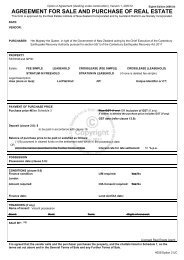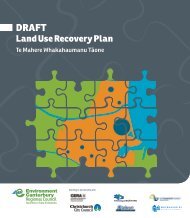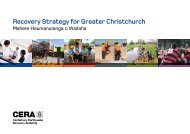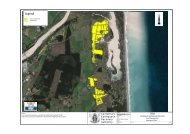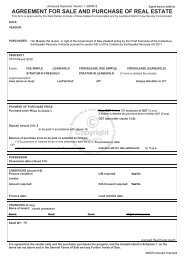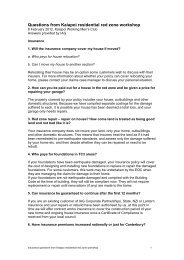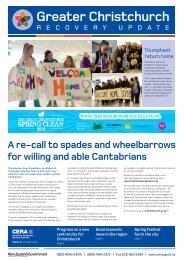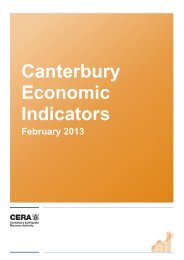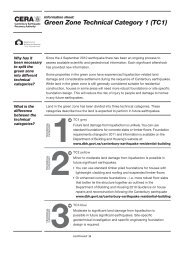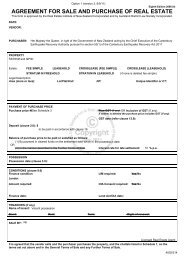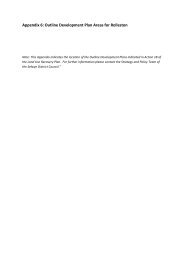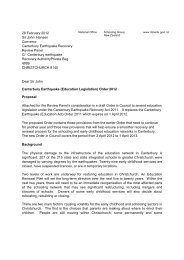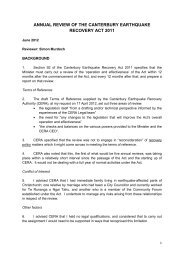June 2013 - Canterbury Earthquake Recovery Authority
June 2013 - Canterbury Earthquake Recovery Authority
June 2013 - Canterbury Earthquake Recovery Authority
You also want an ePaper? Increase the reach of your titles
YUMPU automatically turns print PDFs into web optimized ePapers that Google loves.
Greater Christchurch<br />
<strong>Earthquake</strong> <strong>Recovery</strong><br />
Monitoring and<br />
Reporting Plan<br />
Te Mahere Arotake<br />
Haumanutanga o Waitaha<br />
Summary<br />
The Monitoring and Reporting Plan has been developed under section 8 of the <strong>Recovery</strong><br />
Strategy for Greater Christchurch Mahere Haumanutanga o Waitaha to:<br />
JUNE <strong>2013</strong><br />
• coordinate and outline the responsibilities for monitoring and reporting on the recovery’s progress<br />
• provide a framework and process to track the recovery over time and enable<br />
evidence-based advice and decision making<br />
• outline the ways information will be made available to decision makers and the<br />
community<br />
• enable the assessment of the effectiveness of recovery activities and<br />
spending to help identify any required changes.<br />
CER181.0613B
Monitoring the<br />
recovery of<br />
greater Christchurch<br />
An important part of recovery<br />
is understanding its pace and<br />
progress.<br />
By monitoring and reporting on the<br />
recovery in a clear, planned and<br />
coordinated way, we can assess the<br />
effectiveness of recovery activities. We<br />
can also identify the areas that may<br />
require additional effort or change.<br />
Information about the progress of<br />
recovery helps investors, home owners,<br />
infrastructure developers, service<br />
providers and the wider community to<br />
make decisions critical to the rebuild and/<br />
or their own futures.<br />
<strong>Recovery</strong> Strategy<br />
components<br />
Headline indicators for<br />
<strong>Recovery</strong> Strategy goals<br />
LEADERSHIP and INTEGRATION<br />
• Public Confidence in <strong>Recovery</strong> Decisions<br />
• Public Satisfaction with Communication<br />
and Information<br />
• Strategic Partner Satisfaction with<br />
Coordination<br />
• Public Engagement<br />
ECONOMIC<br />
• Business Activity<br />
• Economic Output<br />
• Economic Confidence<br />
• Labour Market<br />
• Insurance Progress<br />
• Central City Activity<br />
The Monitoring and Reporting Plan<br />
is structured around a framework<br />
involving a number of key<br />
elements that are linked across<br />
the six components of the<br />
<strong>Recovery</strong> Strategy for Greater<br />
Christchurch.<br />
Monitoring headline<br />
indicators for the <strong>Recovery</strong><br />
Strategy goals<br />
Identifying and measuring key<br />
indicators for the <strong>Recovery</strong><br />
Strategy’s goals across the six<br />
recovery components and linking<br />
to supporting datasets and existing<br />
monitoring.<br />
Monitoring recovery programmes and<br />
progress towards goals<br />
Identifying targets and objectives for recovery<br />
programmes to measure their achievements and<br />
effectiveness.<br />
Financial monitoring and reporting<br />
Central government and local authority financial<br />
reporting on the actual and projected spending<br />
of public funds on recovery.<br />
Reporting and review<br />
Developing reports and review processes to<br />
demonstrate transparency and progress and<br />
to show where outcomes are, or are not, being<br />
achieved or where conditions have changed.<br />
LEADERSHIP & INTEGRATION<br />
SOCIAL<br />
CULTURAL<br />
ECONOMIC<br />
COMMUNITY<br />
NATURAL<br />
BUILT<br />
SOCIAL<br />
• Quality of Life<br />
• Educational Achievement<br />
• Mental Wellbeing<br />
• Social Connectedness<br />
• Offending Patterns<br />
• Housing Affordability<br />
CULTURAL<br />
• Arts Participation<br />
• Cultural Events and Festivals<br />
• Sports Participation<br />
• Heritage Retention<br />
• Community Facilities<br />
BUILT<br />
• Land Supply<br />
• Building Activity<br />
• Central City Repair and Rebuild<br />
• Horizontal Infrastructure Repair<br />
• Ease of Travel and Transportation<br />
NATURAL<br />
• <strong>Earthquake</strong> Waste<br />
• Air Quality<br />
• Biodiversity<br />
• Drinking Water Sources<br />
• Waterway Health
Supporting indicators<br />
and datasets<br />
Reporting and<br />
review<br />
Monitoring progress<br />
towards goals<br />
<strong>Recovery</strong><br />
programmes*<br />
LEADERSHIP and<br />
INTEGRATION<br />
SUPPORTING<br />
DATASETS<br />
Additional information on<br />
the outcomes of recovery<br />
activities, such as consumer<br />
spending, manufacturing,<br />
mental health, safety, civil<br />
preparedness etc<br />
Quarterly <strong>Recovery</strong><br />
Progress Report<br />
CERA Annual Report<br />
• <strong>Recovery</strong> Governance and<br />
Coordination<br />
• Iwi Māori <strong>Recovery</strong><br />
• Monitoring and Reporting<br />
• Communication and<br />
Engagement<br />
• Christchurch Central<br />
Development<br />
• Transition Plan<br />
<strong>Canterbury</strong><br />
Economic<br />
Indicators<br />
Other reports on aspects<br />
of economic, social, cultural,<br />
built and natural environment<br />
recovery<br />
ECONOMIC<br />
• Greater Christchurch Business<br />
and Investment Attraction and<br />
Retention<br />
• Business Environment<br />
Online recovery<br />
reporting and links to<br />
supporting information<br />
• Insurance<br />
• Labour Market<br />
Programme<br />
CANTERBURY<br />
WELLBEING<br />
INDEX<br />
AND<br />
CERA<br />
WELLBEING<br />
SURVEY<br />
Financial Monitoring<br />
and Reporting –<br />
Reports of central and<br />
local government<br />
Annual <strong>Canterbury</strong><br />
<strong>Earthquake</strong> <strong>Recovery</strong><br />
Act Review<br />
Achievements<br />
and<br />
Performance<br />
Information on<br />
the achievement<br />
of programme<br />
milestones and<br />
progress towards<br />
<strong>Recovery</strong> Strategy<br />
goals<br />
SOCIAL<br />
• Community Resilience<br />
• Residential Red Zone<br />
• Effective Government Services<br />
• Education Renewal<br />
• <strong>Canterbury</strong> District Health Board<br />
<strong>Recovery</strong><br />
CULTURAL<br />
BUILT<br />
RECOVERY<br />
AND<br />
INFRASTRUCTURE<br />
METRICS<br />
Monitoring<br />
Plan and Indicators<br />
Review<br />
• Arts, Culture and Heritage<br />
Collections<br />
• Heritage Buildings and Cultural<br />
Heritage Places<br />
• Sport and Recreation <strong>Recovery</strong><br />
<strong>Recovery</strong><br />
Programme<br />
Review<br />
BUILT<br />
• Land and Land Use<br />
• Demolition and Operations<br />
NATURAL<br />
ENVIRONMENT<br />
REPORTING<br />
<strong>Recovery</strong><br />
Strategy<br />
Review<br />
• Infrastructure<br />
• Residential Rebuild and Housing<br />
NATURAL<br />
• Natural Environment <strong>Recovery</strong><br />
*Current as at the time of publication<br />
0800 RING CERA I 0800 7464 2372 I Fax (03) 963 6382 I www.cera.govt.nz
Developing<br />
the Plan and<br />
identifying<br />
indicators –<br />
Te whakahiato<br />
To develop this Plan, we reviewed a range<br />
of existing local, national and international<br />
monitoring frameworks and matched them<br />
against the requirements of the <strong>Recovery</strong><br />
Strategy. We also developed a list of potential<br />
measures and indicators of progress<br />
towards the recovery goals, in collaboration<br />
with a working group of strategic partners<br />
(Te Rūnanga o Ngāi Tahu, Environment<br />
<strong>Canterbury</strong>, Christchurch City Council,<br />
Selwyn and Waimakariri District Councils) and<br />
government agencies involved in recovery.<br />
Existing monitoring programmes, reports and<br />
data sources helped to identify what resources<br />
were currently available and relevant. Strategic<br />
partners, representatives across government<br />
and the Community Forum were consulted on<br />
the draft Plan.<br />
Selecting and reviewing indicators<br />
To select indicators, we reviewed the <strong>Recovery</strong><br />
Strategy goals and priorities and identified<br />
the key issues that recovery programmes and<br />
activities would address. A master list of both<br />
‘known/existing’ and ‘desired’ indicators was<br />
developed and discussed with the working<br />
group to determine headline indicators and<br />
supporting datasets. Indicators were assessed<br />
based on their:<br />
• data power (availability and frequency)<br />
• proxy power (relevance, meaning, and<br />
ability to demonstrate and to add value)<br />
• communication power (ability to meet<br />
needs).<br />
Based on these three criteria, we identified the<br />
most powerful indicators for each recovery<br />
component and made them the headline<br />
indicators. Finally, we cross-checked the<br />
selected indicators against the <strong>Recovery</strong><br />
Strategy goals to ensure that together the<br />
indicators would adequately measure the<br />
Strategy’s key issues, goals and priorities.<br />
Continuing to review indicators is particularly<br />
relevant in recovering from a natural disaster<br />
where conditions may change over time.<br />
For example, it may be necessary to review<br />
indicators if more earthquakes or other<br />
natural hazards require a change in focus,<br />
or if impacts on particular groups become<br />
apparent. Another possibility is that new or<br />
better data become available, allowing us to<br />
improve or update the indicators.<br />
Monitoring and reporting that<br />
supports this Plan<br />
The Plan uses a set of supporting monitoring<br />
and reporting sources to avoid duplicating<br />
effort and/or developing new sources of data<br />
that are not needed. The key sources are:<br />
• <strong>Canterbury</strong> Economic Indicators (CERA)<br />
• <strong>Canterbury</strong> Wellbeing Index (CERA) and<br />
CERA Wellbeing Survey<br />
• Infrastructure Metrics & Community Asset<br />
Mapping (CERA)<br />
• Key <strong>Canterbury</strong> Indicators (Building and<br />
Housing Group, Ministry of Business,<br />
Innovation and Employment)<br />
• Census and <strong>Earthquake</strong> Information Portal<br />
(Statistics New Zealand)<br />
• State of the Environment Reporting and<br />
Community Outcomes Monitoring (greater<br />
Christchurch councils)<br />
• Quality of Life Survey (Christchurch City<br />
Council)<br />
• Active NZ Survey (Sport New Zealand)<br />
• New Zealanders and the Arts Survey<br />
(Creative New Zealand).<br />
Reporting and<br />
review – Te<br />
pūrongo me te<br />
arotake<br />
CERA will produce reports in conjunction with<br />
strategic partners and government agencies<br />
to help identify issues and challenges that<br />
are affecting the recovery. These reports<br />
may show a need for a change in priority<br />
or additional effort. The Plan proposes the<br />
following types of reports:<br />
• quarterly <strong>Recovery</strong> Progress reports<br />
• ongoing reports on aspects of economic,<br />
social, cultural, built and natural<br />
environment recovery<br />
• online recovery reporting<br />
• annual financial reports of recovery<br />
agencies.<br />
In addition, CERA will review and report<br />
publicly on the implementation of the <strong>Recovery</strong><br />
Strategy, recovery programmes and progress<br />
towards milestones. The Monitoring and<br />
Reporting Plan, its indicators and the <strong>Recovery</strong><br />
Strategy will be reviewed as required to keep<br />
them current and relevant. Each year, the<br />
Minister for <strong>Canterbury</strong> <strong>Earthquake</strong> <strong>Recovery</strong><br />
will also review and report on the operation and<br />
implementation of the <strong>Canterbury</strong> <strong>Earthquake</strong><br />
<strong>Recovery</strong> Act 2011.<br />
Additional<br />
information –<br />
He kōrero anō<br />
For more information on monitoring and<br />
reporting on the recovery, see the CERA<br />
website (www.cera.govt.nz). Here you will find<br />
the full Monitoring and Reporting Plan plus<br />
information on progress reporting, indicators,<br />
and work by other organisations involved in<br />
monitoring and reporting.<br />
0800 RING CERA I 0800 7464 2372 I Fax (03) 963 6382 I www.cera.govt.nz



